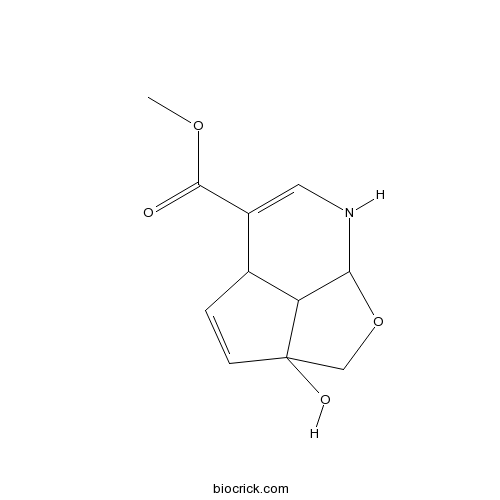GardenineCAS# 139682-36-3 |

Quality Control & MSDS
3D structure
Package In Stock
Number of papers citing our products

| Cas No. | 139682-36-3 | SDF | Download SDF |
| PubChem ID | 197414 | Appearance | Oil |
| Formula | C11H13NO4 | M.Wt | 223.2 |
| Type of Compound | Iridoids | Storage | Desiccate at -20°C |
| Solubility | Soluble in Chloroform,Dichloromethane,Ethyl Acetate,DMSO,Acetone,etc. | ||
| SMILES | COC(=O)C1=CNC2C3C1C=CC3(CO2)O | ||
| Standard InChIKey | QIGMCZARMNNIKC-UHFFFAOYSA-N | ||
| Standard InChI | InChI=1S/C11H13NO4/c1-15-10(13)7-4-12-9-8-6(7)2-3-11(8,14)5-16-9/h2-4,6,8-9,12,14H,5H2,1H3 | ||
| General tips | For obtaining a higher solubility , please warm the tube at 37 ℃ and shake it in the ultrasonic bath for a while.Stock solution can be stored below -20℃ for several months. We recommend that you prepare and use the solution on the same day. However, if the test schedule requires, the stock solutions can be prepared in advance, and the stock solution must be sealed and stored below -20℃. In general, the stock solution can be kept for several months. Before use, we recommend that you leave the vial at room temperature for at least an hour before opening it. |
||
| About Packaging | 1. The packaging of the product may be reversed during transportation, cause the high purity compounds to adhere to the neck or cap of the vial.Take the vail out of its packaging and shake gently until the compounds fall to the bottom of the vial. 2. For liquid products, please centrifuge at 500xg to gather the liquid to the bottom of the vial. 3. Try to avoid loss or contamination during the experiment. |
||
| Shipping Condition | Packaging according to customer requirements(5mg, 10mg, 20mg and more). Ship via FedEx, DHL, UPS, EMS or other couriers with RT, or blue ice upon request. | ||
| Description | 1. Gardenin has regulatory effect on the gene expression in rats with focal cerebral ischemia. |

Gardenine Dilution Calculator

Gardenine Molarity Calculator
| 1 mg | 5 mg | 10 mg | 20 mg | 25 mg | |
| 1 mM | 4.4803 mL | 22.4014 mL | 44.8029 mL | 89.6057 mL | 112.0072 mL |
| 5 mM | 0.8961 mL | 4.4803 mL | 8.9606 mL | 17.9211 mL | 22.4014 mL |
| 10 mM | 0.448 mL | 2.2401 mL | 4.4803 mL | 8.9606 mL | 11.2007 mL |
| 50 mM | 0.0896 mL | 0.448 mL | 0.8961 mL | 1.7921 mL | 2.2401 mL |
| 100 mM | 0.0448 mL | 0.224 mL | 0.448 mL | 0.8961 mL | 1.1201 mL |
| * Note: If you are in the process of experiment, it's necessary to make the dilution ratios of the samples. The dilution data above is only for reference. Normally, it's can get a better solubility within lower of Concentrations. | |||||

Calcutta University

University of Minnesota

University of Maryland School of Medicine

University of Illinois at Chicago

The Ohio State University

University of Zurich

Harvard University

Colorado State University

Auburn University

Yale University

Worcester Polytechnic Institute

Washington State University

Stanford University

University of Leipzig

Universidade da Beira Interior

The Institute of Cancer Research

Heidelberg University

University of Amsterdam

University of Auckland

TsingHua University

The University of Michigan

Miami University

DRURY University

Jilin University

Fudan University

Wuhan University

Sun Yat-sen University

Universite de Paris

Deemed University

Auckland University

The University of Tokyo

Korea University
- EPZ005687
Catalog No.:BCC2219
CAS No.:1396772-26-1
- CGP 52432
Catalog No.:BCC6989
CAS No.:139667-74-6
- PR 39 (porcine)
Catalog No.:BCC5856
CAS No.:139637-11-9
- Purotoxin 1
Catalog No.:BCC6333
CAS No.:1396322-38-5
- 3-Bromoisonicotinic Acid
Catalog No.:BCC8368
CAS No.:13959-02-9
- Epicannabidiol hydrate
Catalog No.:BCN6207
CAS No.:139561-95-8
- Serratriol
Catalog No.:BCN6210
CAS No.:13956-52-0
- Lycoclavanol
Catalog No.:BCN6209
CAS No.:13956-51-9
- Cannabidiol
Catalog No.:BCN6208
CAS No.:13956-29-1
- Fmoc-Leu-ol
Catalog No.:BCC2582
CAS No.:139551-83-0
- 2-(7-Methoxy-1-naphthyl)ethylamine hydrochloride
Catalog No.:BCN1574
CAS No.:139525-77-2
- Buddlejasaponin IV
Catalog No.:BCN5344
CAS No.:139523-30-1
- Amphotericin B
Catalog No.:BCN2564
CAS No.:1397-89-3
- Yunnanxane
Catalog No.:BCN6702
CAS No.:139713-81-8
- BS-181 HCl
Catalog No.:BCC2537
CAS No.:1397219-81-6
- Dunnianol
Catalog No.:BCN6212
CAS No.:139726-29-7
- Isodunnianol
Catalog No.:BCN6213
CAS No.:139726-30-0
- Tenuifoliside A
Catalog No.:BCN2893
CAS No.:139726-35-5
- Tenuifoliside B
Catalog No.:BCC9251
CAS No.:139726-36-6
- tenuifoliside C
Catalog No.:BCN8299
CAS No.:139726-37-7
- Sildenafil
Catalog No.:BCC1947
CAS No.:139755-83-2
- Cucurbitacin E-2-O-Glucoside
Catalog No.:BCC8156
CAS No.:1398-78-3
- Milameline hydrochloride
Catalog No.:BCC7427
CAS No.:139886-04-7
- 3,6'-Disinapoyl sucrose
Catalog No.:BCN2719
CAS No.:139891-98-8
Formation of nitrogen-containing metabolites from geniposide and gardenoside by human intestinal bacteria.[Pubmed:1818345]
Planta Med. 1991 Dec;57(6):536-42.
During the course of our studies on the metabolism of iridoid glycosides by human intestinal bacteria, we found that geniposide (1) and gardenoside (4) were transformed to new nitrogen-containing compounds, genipinine (3) and Gardenine (6), respectively, along with the known aglycones. Although the amounts of new metabolites were somewhat lower than those of the aglycones, they were quantitatively analyzed by means of liquid chromatography/mass spectrometry (LC/MS). Of 25 strains of human intestinal bacteria, Peptostreptococcus anaerobius, Klebsiella pneumoniae, Fusobacterium nucleatum, and Bacteroides fragilis ssp. thetaotus produced appreciable amounts of 3, while a bacterial mixture of human feces produced 10 times or more higher amounts of 3, as compared to the individual strains.


